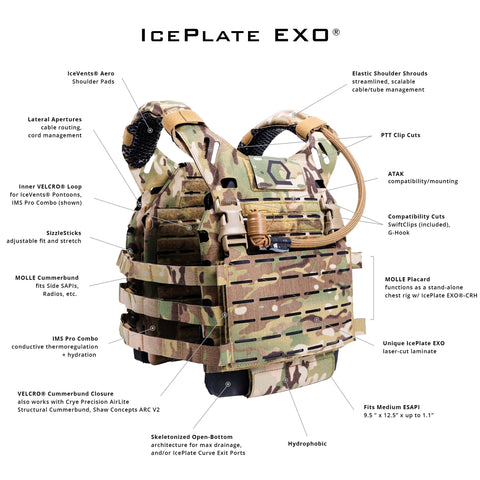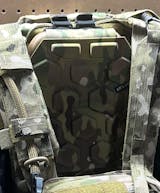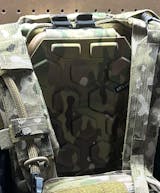Plate Carrier Setup: Everything You Need to Know

A plate carrier is one of the most important pieces of tactical gear you can buy. A plate carrier – to state the obvious – carries hard armor to protect you against rifle-caliber and lesser threats. It also does much more than that; it carries your mission-essential equipment. Properly sized it can allow you mobility and flexibility without weighing you down. They can also help keep you cool in hot climates and warm in cold ones.
Choosing a plate carrier isn’t as simple as buying something off the rack. It should be a thoughtful process, allowing you to choose the one that best supports your mission and your body. This article will help you choose a plate carrier that works for you, starting with the types of plate carriers.
Types of Plate Carriers Setups
There are various types of plate carriers. There aren’t any universally-accepted definitions in this space, but these categories describe the plate carriers you are likely to run across.
Low-Profile/Concealable: Low-profile plate carriers are intended to support low-profile missions – dangerous situations where gunfire may break out, but where overt displays of arms and armament aren’t advisable. These plate carriers will hold ballistic plates close to the body, protecting vital organs. They will lack an provision for attaching pouches or accessories. Low-profile plate carriers fit snugly and are form-fitting so they can be concealed under a shirt or light jacket. Low-profile or concealable plate carriers are often worn by law enforcement or personal security details.
Minimalist Tactical/Uniform: Minimalist tactical rigs offer the bare minimum – a plate pocket in the front and rear, skinny shoulder straps, and a simple strap securing the bottoms of the plate carrier. In addition to two plates, these typically have a provision for mounting MOLLE-compatible pouches like magazine, grenade, and admin pouches. The uniform outershirt-style plate carrier also falls into this category. These are the outshirts often seen on police officers that hold a plate in addition to soft armor. Minimilist tactical plate carriers are generally used to carry a stripped down, no-frills load. These are ideal for LE who only don a plate carrier in extremis or home defenders who don’t want to spend a fortune.
Tactical Plate Carrier: The tactical plate carrier is the standard of the day. Obviously, it will have a front and rear plate pocket. Very likely it will also have generously padded shoulders straps, as it is intended to be worn for hours at a time. A tactical plate carrier will usually have a cummerbund rather than a simple strap down low. The cummerbund will offer a closer fit, as well as providing additional mounting options for additional pockets and pouches. Tactical plate carries have MOLLE (or MOLLE-compatible) webbing on the front and rear and typically have generous velcro panels for infared IFF (Indicator, Friend or Foe) patches, name tapes, morale patches, etc.
Choosing the type of plate carrier for you is largely a matter of determining your operational requirements. Once you know what your mission is, you can begin making decisions about the gear to support it. When you know what kind of plate carrier you need (we will mainly focus on tactical plate carriers here), you can choose one that works best for you.
Choosing the Right Plate Carrier Setup
Aside from the type of plate carrier you need, there are a ton of other factors to think about when choosing a plate carrier.
Fitment: Size and correct fitment is the first and most important consideration. A properly sized plate carrier will allow you to run, jump, climb, bend, grapple, and shoot without compromising your range of motion. Plate carriers should also be chosen based on the size of ballistic plate you wear. Just as a large plate won’t fit in a small plate carrier, a small plate won’t fit correctly in a large plate carrier and won’t provide proper protection. Just as importantly, the correct size will also hold the body armor plates in the correct position for maximum ballistic protection. Plates should sit nice and high.
Many prefer the top of their front plate sitting just below the sternal notch, the “U”-shaped divot at the top of the sternum. This positions the plate to protect vital organs like the heart, lungs, and liver, as well as major vessels like the aorta and superior and inferior vena cava. Though often overlooked, the rear plate should sit nice and high, too. For correct sizing of a plate carrier, check out our article, “What Size Plate Carrier do I Wear?”
Load Bearing Capability: Plate carrier setup is largely dependent on your mission, and the next consideration is the amount of load-carrying capacity you need. If you are working with a plate carrier on a regular basis, odds are you want to attach some mag pouches, medical supplies, and other accessories. Your plate carrier setup should support your mission needs with enough MOLLE attachment, and the underlying structure to support it.
Qore Performance Plate Carriers: one of the best tactical plate carriers on the market is the IcePlate EXO® by Qore Performance. The Qore Performance IcePlate Exo is well adapted for use with the Qore Performance IcePlate Curve. Of course, that doesn’t matter if this isn’t a top-notch plate carrier to begin with, and it is. Made in the U.S.A., our craftsmanship is without peer, and is known for precise, exacting, and time-consuming attention to detail. The Qore Performance IcePlate EXO® is designed to maximize human performance, has excellent flexibility, and of course, our totally unique integrated thermoregulation capabilities (IcePlate Curve, IceVents ventilation, IceShield Plus plate carrier hand warmer).
Our plate carriers integrate with the Qore Performance IcePlate Curve®. The IcePlate Curve perfectly conforms to a SAPI-cut plate, and carries 50-ounces of water. This water can be frozen to keep you cool in hot climates, and provide hydration once it melts. Or, it can be filled with hot water to harness water’s tremendous energy-storage potential to keep you warm in the cold. Rather than carry a floppy water bladder that might burst, doesn’t retain heat or cool, and won’t let you get all the water out, carry an IcePlate (or two) with an integrated drinking hose.
Armor Plates and Inserts
Of course, it is worth mentioning the armor in your plate carrier. The armor you choose should be decided by likely threats you face. Body armor comes in two broad categories: soft and hard. Soft body armor typically goes up to NIJ Level IIIA, meaning it will stop 9mm, .357 Magnum, and .44 Magnum when fired from a handgun. This is what the typical law enforcement officer wears. Unfortunately, soft armor provides no protection from rifle rounds.
Hard armor provides the ballistic protection necessary against rifle fire. Hard plates come in two recognized protection levels: Level III and Level IV. Level III armor provides ballistic protection against rifles up to 7.62x51mm NATO (.308 Win) using standard, FMJ ammunition. Level IV armor provides extra ballistic protection. Level IV plates are certified to stop an armor-piercing round from a 7.62 rifle.
Qore Performance offers the DFNDR line of ballistic hard plates. These are offered in Level III and Level IV, as well as Level IIIA. Though Level IIIA is widely available in soft-armor, this provides a hard plate that is far less expensive than a Level III or IV plate. This makes them ideal for use as inexpensive training plates; ballistic plates should be handled carefully to preserve their ballistic protection. These plates are also ideal for situations where pistol threats are the only credible concern.
One important note: there are a lot of steel plates on the market with dubious armor protection claims. Most of these plates do not offer spall protection – that is an ability to absorb the bullet on impact and prevent it from ricocheting up into your face. Use caution when purchasing plain steel plates or plates without clearly defined NIJ certification levels.
Plate Carrier Accessories
If you have to spend hours in a plate carrier in the heat, you know how miserable it can be, and the cooling, hydration, and comfort accessories from Qore Performance can make life massively easier.
IcePlate Curve is one of the most innovative products to hit the body armor space since the ceramic hard plate itself. You have to carry water; you might as well let that water cool you down or warm you up before you drink it. Let it push you through the initial operational phase of your mission so you have plenty of fuel left in the tank once you get on target.
We also offer a number of accessories to make the heavy armor plates a little bit easier to bear when that mission hits it’s twelvth, fourteenth, or twentieth hour. IceVents Aero minimalist plate carrier shoulder strap pads allow continuous, omnidirectional airflow to keep your shoulders cool. IceVents technology is also available for holsters, battle belts, and other gear. Another accessory to make your plate carrier cooler is the IceVents Classic Ventilation Pontoons – raised strips that run the length of your plate rack, down each side. This holds the plate carrier off your body allowing airflow to your chest and back.
The Qore Performance Difference
Qore Performance has made radical innovations when it comes to body armor and thermoregulation. Not only is our IcePlate a complete reimagining of plate carrier hydration, our plate carriers are some of the finest available anywhere. If you’re willing to settle for “good enough,” look elsewhere. If you want the absolute best, buy Qore Performance with confidence.











Leave a comment